When there is something critical that can push our research much further I really go deep into the material to learn what it means and this recent finding may be one of the biggest finds I have gotten in a while. It seems to be one of those studies that connects many of the subjects that the serious height increase researchers would have seen before and gives a few big ideas on how to possibly stimulate height increase. The implications which I would learn is quite immense.
Update 3/8/2013: In the 7th Natural Height Growth Podcast Episode with Tyler we have only briefly mentioned the fact that I was looking at this phenomenon of deer antler growth to possibly find general growth principles which shows why this mamaliam bone growth is possible. I have directed him to the study so he can see the type of research I was doing a few weeks ago. This post will go much deeper into the technical details. I will be dissecting the PubMed study below and then give a interpretation on how we can use the theory for height increase and how to grow taller.
From PubMed study…
Recapitulation of the parathyroid hormone-related peptide-Indian hedgehog pathway in the regenerating deer antler. (source link)
Abstract
C. Faucheux, B.M. Nicholls, S. Allen, J.A. Danks, M.A. Horton, and J.S. Price
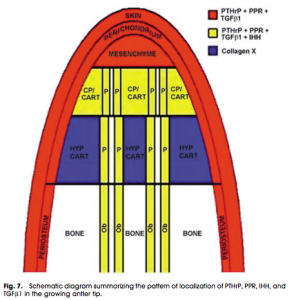 Parathyroid hormone (PTH)-related peptide (PTHrP) and the PTH/PTHrP receptor (PPR) play an essential role in controlling growth plate development. The aim of the present study was to use the deer antler as a model to determine whether PTHrP and PPR may also have a function in regulating cartilage and bone regeneration in an adult mammal. Antlers are the only mammalian appendages that are able to undergo repeated cycles of regeneration, and their growth from a blastema involves a modified endochondral process. Immunohistochemistry was used to establish sites of localization of PTHrP and PPR in antlers at different stages of development. The pattern of Indian Hedgehog (IHH) and transforming growth factor-beta1 (TGF�1) distribution was also investigated, because PTHrP expression in the developing limb is regulated by IHH and during embryonic growth plate formation TGF�1 acts upstream of PTHrP to regulate the rate of chondrocyte differentiation. In the antler blastema (<10 days of development), PTHrP, PPR, and TGF�1 were localized in epidermis, dermis, regenerating epithelium, and in mesenchymal cells but IHH expression was not detected. In the rapidly growing antler (weeks 4 – 8 of development), PTHrP, PPR, and TGF �1 were localized in skin, perichondrium, undifferentiated mesenchyme, recently differentiated chondrocytes, and in perivascular cells in cartilage but not in fully differentiated hyperytrophic chondrocytes. IHH was restricted to recently differentiated chondrocytes and to perivascular cells in cartilage. In mineralized cartilage and bone, PTHrP, PPR, IHH, and TGF�1 were immunolocalized in perivascular cells and differentiated osteoblasts. PTHrP and PPR were also present in the periosteum. TGF�1 in vitro stimulated PTHrP synthesis by cells from blastema, perichondrium, and cartilage. The findings of this study suggest that molecules which regulate embryonic skeletal development and postnatal epiphyseal growth may also control blastema formation, chondrogenesis, and bone formation in the regenerating deer antler. This finding is further evidence that developmental signaling pathways are recapitulated during adult mammalian bone regeneration. Developmental Dynamics 231:88 –97, 2004.
Parathyroid hormone (PTH)-related peptide (PTHrP) and the PTH/PTHrP receptor (PPR) play an essential role in controlling growth plate development. The aim of the present study was to use the deer antler as a model to determine whether PTHrP and PPR may also have a function in regulating cartilage and bone regeneration in an adult mammal. Antlers are the only mammalian appendages that are able to undergo repeated cycles of regeneration, and their growth from a blastema involves a modified endochondral process. Immunohistochemistry was used to establish sites of localization of PTHrP and PPR in antlers at different stages of development. The pattern of Indian Hedgehog (IHH) and transforming growth factor-beta1 (TGF�1) distribution was also investigated, because PTHrP expression in the developing limb is regulated by IHH and during embryonic growth plate formation TGF�1 acts upstream of PTHrP to regulate the rate of chondrocyte differentiation. In the antler blastema (<10 days of development), PTHrP, PPR, and TGF�1 were localized in epidermis, dermis, regenerating epithelium, and in mesenchymal cells but IHH expression was not detected. In the rapidly growing antler (weeks 4 – 8 of development), PTHrP, PPR, and TGF �1 were localized in skin, perichondrium, undifferentiated mesenchyme, recently differentiated chondrocytes, and in perivascular cells in cartilage but not in fully differentiated hyperytrophic chondrocytes. IHH was restricted to recently differentiated chondrocytes and to perivascular cells in cartilage. In mineralized cartilage and bone, PTHrP, PPR, IHH, and TGF�1 were immunolocalized in perivascular cells and differentiated osteoblasts. PTHrP and PPR were also present in the periosteum. TGF�1 in vitro stimulated PTHrP synthesis by cells from blastema, perichondrium, and cartilage. The findings of this study suggest that molecules which regulate embryonic skeletal development and postnatal epiphyseal growth may also control blastema formation, chondrogenesis, and bone formation in the regenerating deer antler. This finding is further evidence that developmental signaling pathways are recapitulated during adult mammalian bone regeneration. Developmental Dynamics 231:88 –97, 2004.
© 2004 Wiley-Liss, Inc. Received 28 August 2003; Revised 10 March 2004; Accepted 24 March 2004
Analysis & Interpretation of the Abstract:
The study the researchers did was to see whether the PTHrP/PPR pairs have any type of regulation function on the cartilage and bone regeneration in adult mammals. Note: I would assume most of the people reading this post are adult mammals.
I had written before in a previous post about the possible that the Parathyroid Hormone related Peptide, the PTHrP being the possible compound that we should be focusing on increasing expression and concentration the most if we were to take a crack at finding a non-invasive, non limb-lengthening method. The post was “Parathyroid Hormone And Parathyroid Hormone-Related Protein May Lead To Non-Invasive Epiphyseal Growth Plate Regeneration (Big Breakthrough)” The idea from that post was that theire seemed to have been enough studies and articles published showing that the PTHrP can cause all the other growth factors and chondrogenic process to restart again to form more chondrocytes, thus cartilage, thus epiphyseal plates. Of course the connection between PTHrP expression, and overgrowth turning into cancer, still showed as Tyler pointed out that it might be the indian hedgehog, IHH, which seems to be regulating the PTHrP.
First, let’s look at the introduction. In the introduction, the writers give us a good introduction at seeing the analog and similarities between how deer antlers grow and how the human limb grows during the endochondral ossification process.
We look at 4 main growth factors or regulating factors.
- Parathyroid Hormone related Protein, PTHrP
- Indian Hedgehog, IHH, ihh
- PTH/PTHrP receptor, PPR
- Transforming Growth Factor Beta 1, TGFBeta1
The researchers have already done their research and read the more important studies which show how the PTHrP, IHH and others work together to regulate the process of endochondral ossification in the growth plate. It seems that for the deer antlers, they actually stop growing in length when the testosterone is increased up to a certain level. That to begin with is something that is noted maybe for later.
Others things to note is that the retinoic acid and its receptor will control how the growth plate behaves, as we have seen in previous studies and written about in previous posts.
The PTHrP itself does two main functions, stimulate chondrocyte proliferation, and inhibit the differentiation of chondrocytes. It also can regulate the differentiation of antler osteoclasts.
The PTHrP/PPR combo regulate chondrocyte differentiation. The indian hedgehog, IHH, can regulate the expression of the PTHrP. It is expressed in the prehypertrophic chondrocytes. Both the PTHrP and the IHH control differentiation of growth plates chondrocytes.
Not just the IHH, but also the TGFBeta-1 might also be a primary regulator of PTHrP. It has been found from immunohistological studies that the mRNA of the TGFBeta-1 has been found in antler tissues. The TGFBeta-1 acts upstream of PTHrP to regulate the rate of hypertrophic differentiation and also increase the PTHrP expression in osteoblasts.
Now let’s see the schematic on how the deer antler components are arranged.
After the old antler is completely grown and reaches maximum length, it stops growing and falls off. The stump that is left over has a sort of wound in the center of the pedicle, which is the thing that juts out of the deer’s head. The wound after a few weeks somehow manages to form a blastema, and the blastema is what can grow. There are 2 main layers and 4 sub layers to the growing antler.
You have the antler skin, called the velvet, which breaks apart into two adjacent layers called the epidermis and the dermis.
You than have the perichondrium underneath the velvet, which has two layers as well, the outer layer which is more collagenous, and the inner layer which is filled with mesenchymal progenitor stem cells which have not been differentiated yet. These progenitor cells have not shown to express alkaline phosphatase yet so they are not chondrocytes in the hypertrophic stage. They are not expressing collagen Type II so they are not at the proliferation stage yet either. When the mesenchymal stem cells do finally manage to start differentiation ,somehow they manage to be able to do it in stacked columns, Between the chondrocytes are the vascular channels and the perivascular tissue which have osteoclast and osteoblast progenitor cells there already. The mesenchyme and the chondrocytes which form from it have cartilage like tissue below it and below that cartilage is the mineraliazed cartilage tissue.
Remember now, the researchers were looking at how the four main growth regulating factors were localized in the growing antler over time from the initialy deer antler falling off leading a fresh wound, through when the blastema forms, and when the blastema turns into something much bigger.
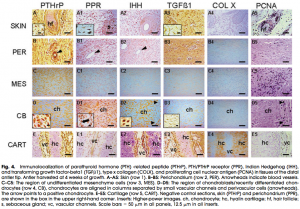 What we are finding if we review the chart to the right is that the PPR and the PTHrP seem to be localized in almost the same places during the blastema formation ,except that the PPR expression can’t be found in the layer of the perichondrium that is filled with blood vessels. The chart is very nicely displayed in showing how much the expression of PTHrP, PPR, TGFBeta-1, IHH, and Collagen X is going on in each subjacent layer, from the outer epidermis, down to the bone.
What we are finding if we review the chart to the right is that the PPR and the PTHrP seem to be localized in almost the same places during the blastema formation ,except that the PPR expression can’t be found in the layer of the perichondrium that is filled with blood vessels. The chart is very nicely displayed in showing how much the expression of PTHrP, PPR, TGFBeta-1, IHH, and Collagen X is going on in each subjacent layer, from the outer epidermis, down to the bone.
Both the PTHrP and the PPR don’t seem to show expression in fully differentiated chondrocytes, which sort of validates the idea that maybe the PTHrP as well as the PPR being used in a way to reverse or at least inhibit complete cartilage to bone conversion.
The IHH has found in very recently differentaited chondrocytes but not found in fully differentiated chondrocytes. As for the TGFBeta-1, we saw that the TGFBeta-1 expression was similar to the PTHrP but at a lower level of concentration or intensity.
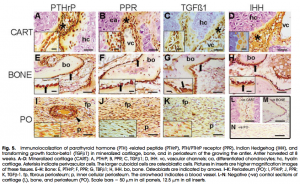 All 4 the ihh, the pthrp, tgfbeta-1 and the ppr call showed expression in at least the perivascular tissue between the chondrocytes and the osteoblasts in the perivascular tissue. It might be a good idea for any serious height increase researcher to look over the chart.
All 4 the ihh, the pthrp, tgfbeta-1 and the ppr call showed expression in at least the perivascular tissue between the chondrocytes and the osteoblasts in the perivascular tissue. It might be a good idea for any serious height increase researcher to look over the chart.
The researchers wrote in the discussion section that …“PTHrP and IHH are “master regulators” of chondrocyte proliferation during endochondral bone formation and IHH also regulates osteoblast differentiation”
What may be the most insightful and the most important part to the study was the section…
“….proposed that antler regeneration represented a failure of scar formation, based on his observation that suturing the skin over the regenerating blastema inhibited antler development.”
This seems to suggest that everything we have been thinking about and assuming about how to grow taller may be completely wrong, and just the opposite. We see that the TGF-Beta1 expression is very low while the local expression of the PTHrP and the PPR are localized to the epithelium layer and the mesenchymal progenitor cell level. We know from so many other PubMed studies that the TGF-Beta1 is not just a osteogenic and a chondrogenic growth factor regulator, but that the process of chondrogeneis and osteogenesis suggest that the wound made from some type of fracture would be healed over. The researchers are proposing that the inhibition of deer antler stump wound closure is what actually allows the antlers to be ever formed in the first place.
The other big thing to note is that during the early blastema formation/ development stages the IHH expression is not found, but the PTHrP is found. This shows that at least for deer antler regeneration the IHH is not used as a regulator on PTHrP expression. This would agree with my proposed idea from the post “Parathyroid Hormone And Parathyroid Hormone-Related Protein May Lead To Non-Invasive Epiphyseal Growth Plate Regeneration (Big Breakthrough)“. The big thing that developed after writing that post was that we are not sure whether the IHH or the PTHrP was the more important growth factor for growth plate regulation. Like the researchers said, the PTHrP and the IHH are the two master regulators. Tyler has said that it seems that the IHH is what will regulate PTHrP but we also realize that the PTHrP-IHH is not a simple regulator-regulated relationship but a feedback loop system unit for analysis. This means that not only does the IHH regulate the PTHrP expression, but the PTHrP regulates the IHH expresson too.
So this thing turns into a feeback loop that regulates itself. So which one comes first, IHH or PTHrP? It is similar to the old chicken-egg paradox, as to which one came first. Which one is more important since it is what will be the original growth factor to start all the rest of the growth factors in a cascade to possibly regenerate cartilage again. I say that this study and article seems to validate and give more evidence towards the idea that the PTHrP is the compound with more important for our endeavor of height increase and to grow taller.
Of course this is not to take away the importance of the other 3 main compounds studied in this study. The researchers learned that the TGF-Beta1 can dramatically increased the expression of PTHrP.
Faucheux and Price (1999) stated that ” PTHrP does not appear to regulate proliferation of progenitor cells derived from perichondrium” this sort of puts a dent in our height increase ideas, since we can’t just use the PTHrP injected into perichondrium to stimulate the inner perichondrium layer cells to to through chondrogenesis and proliferate. What the writer seem to suggest is that the PTHrP is used to regulate proliferation of progenitor cells derived from the mesenchyme instead.
I quote the section from Discussion
However, once chondrogenesis is evident, it may maintain proliferation of chondroprogenitor cells, since our earlier in vitro observations showed that PTHrP inhibited differentiation but stimulated growth in chondrocyte micromass cultures (Faucheux and Price, 1999). The observation that there is no PTHrP in terminally differentiated, nonproliferating chondrocytes in the blastema would support this suggestion
So if we can just get the chondrogenetic process started with the right intial growth factor spark ,we can sustain the proliferation capacities of the few perichondrium cells using PTHrP. PTHrP is not doubt very important. What is interesting for the researchers and myself is that fact that the PTHrP expression was seen in the blood vessel layer of the perichondrium but the PTH/PTHrP receptor (or PPR) was not. The amazing thing for these regenerating deer antlers is that the PTHrP can regulate itself because the PPR expression was localized to the antler perichondrium nonvascularized region.
Implications For Height Increase
 We are seeing that the PTHrP and its receptor the PPR are two of the most critical factors and they seem to be the key factor that separates the epiphyseal cartilage and the regenerating antlers found in deer.
We are seeing that the PTHrP and its receptor the PPR are two of the most critical factors and they seem to be the key factor that separates the epiphyseal cartilage and the regenerating antlers found in deer.
Like with humans, the increase in some type of androgen, this time being the testosterone, is what will cause the longitudinal growth of the “bone” like material to stop. For humans, that was the androgen estrogen.
The few things we learn in this study has dramatically changed the way we view longitudinal bone growth. the thing that is most interesting is that we found out that what can probably help with bone fracture healing can actually inhibit bone length growth.
Let’s look at the diagram on the right and see where it is similar to a growth plate but is also different. This bone area which will eventually protrude from the antler stump has a specific growing pattern.
The blastema formed from the epithelial tissue and the wound made by the antler falling off is something I am not sure of yet.
You have the 2 layer perichondrium which will have the PHTrP and the PPR to start with. The IHH is not found in the perichondrium and the TGF-Beta1, while it would increase the PTHrP, is also low.
So you have the raw material first, the mesenchymal progenitor at the tip, surrounded by the perichondrium, and the skin layers, which are elastic. If you imagine how the growing process would go, it would be very similar to how the long bones grow longer. The top part does not move forward and leave the cartilage to be ossified later. It seems more like that the chondrocytes that are differentiated by the mesenchyme pushes themselves on top of each other, which would automatically result in a stacking columnar formation. The cells are aligned neatly in a one 2 dimensional plane. If they are to proliferate, the newly created chondrocytes would push down the old chondrocyte on top of the older chondrocytes. if then the chondrocytes can then expand in size, they can push each other further apart and widen the cartilage in the vertical direction, which is growing taller.
The thing is that as adult humans with closed epiphyseal plates, we still have the perichondrium, and the mesenchyme, which will be in random found in the trabecular bone matrix in the epiphysis ends of the long bones. Obviously we have the bones. What we don’t have are the cartilage.
But do we need the cartilage to work?? No, the diagram on the right suggest that we might not need to have cartilage to do the transplant,, since the mesenchyme with the right growth factors will create the cartilage or at least the stacking chondrocytes automatically.
We could say that theoretically the core reason the regeneration of deer antler can even happen is because of the blastema, but a blastema is just a dense packing in maybe a certain order of undifferentiated pluripotent stem cells. we have that in the human adult in the epiphysis since the human marrow is usually what people ask to give up in some cancer treatments, but they are not that pure and only made up of say the cells, but also have a lot of bood vessels going through.
If we wanted to say change the concentration or distribution of the factors analyzed like PTHrP, PPR, TGF-Beta1, or IHH, we could theoretically inject through syringes certain areas of our body to get the increased or right amount of growth factor needed to increase height. Growth factors should not, and would not be the main contraint on why the deer antler can keep regrowing after each year, but the adult human epiphyseal growth plate can’t.
But now I don’t think we need the plates!. That”s right, I said it. At this point in the research, I don’t think we need to bring back the growth plates to grow taller.
If we have all the raw elements in our long bones already, then why are we not shooting up in height? If we look at the system not in terms of elements, but in terms of the type of tissue that surrounds the system, then it is obvious. The deer antler has the mesenchyme progenitor cells aligned directly next to the skin tissue. The dermis and epidermis is far, FAR easier to stretch and push apart than bone. The mesenchyme directly creates the cartilage. I would suggest at this point then that the limiting element in how long the deer antler can grow to is the amount of mesenchyme that is still left in the antler tip. If that is the case, to restart the longitudinal growing process in the antlers of deer, we just have to inject a packet of undifferentiated pluripotent stem cells in the tip of the antler and it would restart the growing again.
So what is the external or surrounding element that is really the limiting contraint? It is the bones themselves. The mesenchyme is not directly touching the perichondrium. There is a relatively thick part of cortical bone that envelops any mesenchyme in the epiphysis. The bone is disrupting the mesenchyme-perichondrium adjacent layering that we find in the deer antler. Of course, the skin was also touching the air, or air molecules. In the human synovial joint the knees, the covering of the perichondrium is the articular cartilage. However what is covering the mesenchyme? It is not the perichondrium like in the antlers. It is a very thick layer of cortical bone. That is what is keeping the top of the bone, the epiphysis from pushing the bone longer due to chondrocytes produced. If the cortical bone, even if it is at the top of the long bone was gone, we would have mesenchyme subjacent to the perichondrium. Then the long bone would increase longitudinally.
This post and main point would then validate the idea I had proposed before in “An Alternative Explanation On Why The LSJL May Actually Help People With Closed Growth Plate Increase Height And Grow Taller (Big Breakthrough!)” and then would do a YouTube video explaining the idea for the Hammer and Chisel Method in the post “The Chisel And Hammer Supplement Technique Explained Through Video“
So then what can we actually do? What should the reader be taking away from this post?
Then can the same idea be transferred to humans? If we look at the bones of humans, can we find something of a system in adult humans where mesenchyme or a group of pluripotent or multipotent undifferentiated is touching perichondrium?? Actually yes. Let’s remember back to the idea that the perichondrium is actually two layers. The inner layer is around 15-20 cells thick. Those cells can theoretically be differentiated into the chondrogenic lineage. the way the outer layer of the long bones in the lower limbs is arranged next to each other would be similar to the deer antler arrangement.
So for regenerated longitudinal growth in deer antlers we have skin/perichondrium/mesenchyme/cartilage/bone
For the human long bone layering, we have articular cartilage/outer fibrous collagenous periosteum/cambium layer of the periosteum/ cortical bone, mesenchyme.
There is only one layer-layer arrangement are where both system have the exact perichondrium/mesenchyme arrangement we are looking for. As luck would have it, it is also not being completely surrounding on all sides by the cortical bone. If it was surrounded by cortical bone, it would NEVER work since the cortical bone is way to strong to pull apart by the undifferentiated progenitor stem cells when they do differentiate into the chondrocytes we want them to be in. However since that one layer of mesenchyme is only 15-20 cells thick, we would only be able to get a very limited amount of real height growth, maybe 4-5 cms which Tyler and St.it has stated that they have received.
Note: This idea we are talking about is what has been proposed as a reason why the LSJL method works, due to appositional growth of the subperiosteal layer.
Note: The perichondrium is different from the periosteum, but I am assuming that the two connective tissues are similar since one of them comes from the other.
If we have that area, then I propose then at least theoretically we will be able to regrow cartilage using the mesenchyme with the right factors like the PTHrP and PPR directing it, and don’t need some type of cartilage implant from an external source. This is assuming that it is not completely surrounded by hard cortical bone.
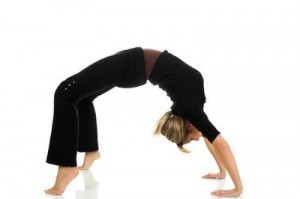 So is it possible that the backbridging pictured to the right can make a person grow taller at least temporarily by stretching out their vertebrate or spine?
So is it possible that the backbridging pictured to the right can make a person grow taller at least temporarily by stretching out their vertebrate or spine? 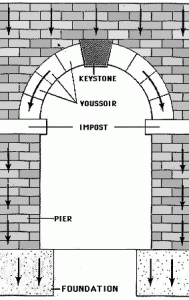 This is similar to the architecture design known as the roman arch. Notice that with the roman arch, the arch stays in placed being squeezed into stability due to the weight from above it. That is similar to what the human body’s intervertebral disks do when they are bend in in the opposite direction and the weight of the body pushes downward on the vertebrate.
This is similar to the architecture design known as the roman arch. Notice that with the roman arch, the arch stays in placed being squeezed into stability due to the weight from above it. That is similar to what the human body’s intervertebral disks do when they are bend in in the opposite direction and the weight of the body pushes downward on the vertebrate.



